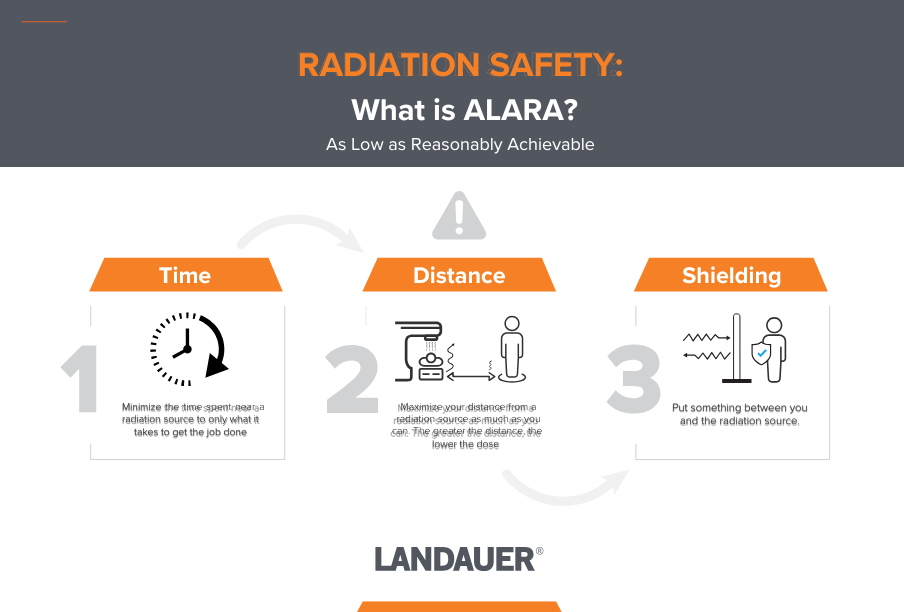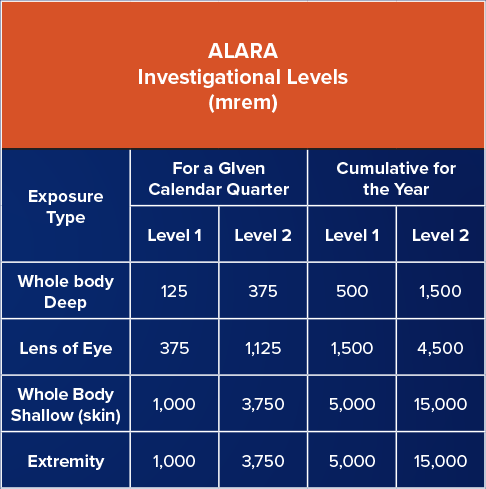
ALARA Radiation Dose Levels and Investigations
The Basics of ALARA
The acronym ALARA stands for “As Low As Reasonably Achievable.” It is a concept based on the linear no-threshold hypothesis, which states that all exposure to radiation carries a risk of detrimental effects that increase with the dose. However, the acronym itself prompts the question, “What is 'reasonable'?” For instance, if wearing one protective apron in an interventional radiology setting provided good protection from radiation, why not wear two?
Examining this proposition would reveal that the second lead apron would not significantly reduce the dose, and the extra weight could interfere with one's work. In regard to ALARA, the term "reasonable" is intentionally flexible. The definition provided by the Nuclear Regulatory Commission (NRC) defines ALARA in the Title 10, Code of Federal Regulations, Part 20.1003 states,
"…making every reasonable effort to maintain exposures to radiation as far below the dose limits in this part as is practical consistent with the purpose for which the licensed activity is undertaken, taking into account the state of technology, the economics of improvements about state of technology, the economics of improvements about benefits to the public health and safety, and other societal and socioeconomic considerations, and about utilization of nuclear energy and licensed materials in the public interest."

In radiation safety, ALARA (As Low As Reasonably Achievable) levels are thresholds set to keep radiation dose levels below regulatory limits. However, the ALARA concept encourages radiation safety professionals and supervisors to actively seek ways to further reduce exposure, rather than simply following static regulatory guidelines. This approach provides flexibility in dealing with unique workplace challenges and circumstances while aiming to minimize radiation dose levels. In practical terms, we implement ALARA by reducing procedure time, maximizing distance from the radiation source during procedures, and utilizing radiation shielding as appropriate.
ALARA Level 1 and Level 2 Explained
ALARA levels should be developed in accordance with the Radiation Protection Program (RPP) and the sources of ionizing radiation utilized at your facility. The NRC recommends establishing ALARA Levels 1 and 2 at 10% and 30% of the quarterly radiation dose levels. Be mindful that state regulations may be more stringent than the NRC standards. The Radiation Safety Officer (RSO) or Individual Responsible for Radiation Protection (IRRP) should consult with the state regulatory agency to ensure the ALARA levels they establish are appropriate for their Radiation Protection Program.

The threshold for ALARA Level 1 is a quarterly value obtained by dividing the annual dose limits by four and typically using 10% of that value. It is not unusual for an employee to exceed ALARA Level 1. In most cases, the action taken for employees exceeding ALARA Level 1 would be to notify them of the exposure and remind them of the ALARA concepts of time, distance, and shielding.
NOTE: For both ALARA Level 1 and 2 investigations, the RSO or IRRP will determine if the dose was received by the individuaol or recorded ona a misplaced or improperly worn dosimetry.
The threshold for ALARA Level 2 is determined quarterly by dividing the annual dose limit by four and typically applying a percentage of either 25% or 30% of that value. The RSO or IRRP promptly investigates all personnel exposures equaling or exceeding ALARA Level II to determine the root cause. In organizations with a Radiation Safety Committee (RSC), the RSO or IRRP will likely interview employees exceeding ALARA Level II in person. The committee meeting minutes include an investigation report, actions to prevent recurrence, the individual's dose records, and a summary of the RSC’s discussion. The minutes containing these details may be forwarded to the organization’s management to be readily available for regulatory agencies and other authorized inspectors. However, in all cases, your local ALARA policy or RPP will define the actions to be taken when ALARA Level 2 is exceeded.
Conducting an ALARA Investigation
To ensure best practices, a questionnaire should be created and sent to employees whose exposure exceeds ALARA Level 2. Additionally, those employees should be interviewed in person if they meet this criterion. It is essential to communicate to the affected employees that these interviews are not punitive; their purpose is to determine the root cause of the increased dose.
The interviews should take place in a setting that respects the employee's privacy. While the questions will be similar or identical to those on the written questionnaire, the in-person format allows for additional time. It provides an opportunity for the affected employee to elaborate on their responses. Typical questions include:
- Did you wear your dosimeter(s) properly?
- What isotope(s) or X-ray sources may have caused this exposure?
- Was your dosimeter stored in the approved storage location when not in use?
- In what location did you perform the majority of your work?
- Did you wear your dosimeter at another facility?
- Could your dosimeter have been subject to environmental damage (e.g., heat or cold)?
- Were you a patient during this period receiving diagnostic or therapeutic radiation?
- Do you suspect that someone intentionally exposed or wore your dosimeter?
- What personal protective equipment did you use during this period?
- Was your exposure time or workload greater than usual during this period?
- Did you hold patients during this period?
- To the best of your knowledge, do you believe you received the reported dose?
- Were co-workers present during your work? If so, list their names.
- What actions could you take to prevent similar exposure events in the future?
The interview may not identify the root cause for the dose. This is okay. The investigation with supporting documents should be completed even if the root cause is not identified.
The Importance of ALARA Investigations
In addition to identifying the root cause and other factors resulting in the elevated exposure, the investigation should assist the affected employee and the RSO or IRRP in developing corrective measures to prevent recurrence. If the affected employee is nearing the annual dose limit, corrective measures may include limits on procedure involvement, procedure time, or unsupervised use of radiation sources. These measures ensure ongoing safety, regulatory compliance, and a demonstrated commitment by the organization’s management to the ALARA concept.
Best Practices for Radiation Workers
As a reminder to employees working with sources of ionizing radiation, you are all safety officers. Ensure that you and your coworkers are practicing ALARA concepts (i.e., Time Distance, and Shielding) as a part of maintaining a Safety Culture in the workplace, including:
- Understanding and demonstrating personal responsibility for behaviors and work practices that support radiation safety (e.g., time distance, and shielding; the proper use and placement of dosimeters, etc.)
- Actively participating in pre-procedure briefings and understanding your responsibility to raise safety concerns before work begins.
- Taking ownership of the preparation and execution of assigned work activities
- Raising radiation safety concerns, including those identified by others
- Understanding the importance of timely reporting and cooperation in investigations
LANDAUER ALARA Service and ALARA Recap Reports
LANDAUER has an ALARA Service and ALARA Recap reports that can help you with regulatory compliance. ALARA Service is a completely digital workflow that simplifies the management of ALARA notifications, tracking, and record-keeping. The customizable letter advises the employee about the level, exposure type, and amount of exposure, and if it exceeds Level 2, provides a questionnaire for the employee to return.
LANDAUER ALARA reports (i.e., the ALARA Recap) are generated quarterly and annually. These detailed reports provide monthly breakouts of exposure by individual and show whole body and extremity exposures. Quarterly reports flag individuals who have exceeded Levels 1 and 2 for the quarter and year. In contrast, annual reports quickly show trends by individuals and departments for the year. Reports track both individual and collective doses. The ALARA Service and ALARA Recap report are available on myLDR.
Keeping Employee's Radiation Dose Levels at a Minimum
As a reminder, ALARA (As Low As Reasonably Achievable) levels are set to monitor and minimize occupational radiation exposure. When exceeded, notifications and investigations are triggered to ensure worker safety and adherence to radiation protection guidelines. These steps are necessary to maintain staff safety and compliance and should in no way be seen as a form of discipline. Check out our other blog posts to get more information on monitoring staff and personnel for radiation exposure.

